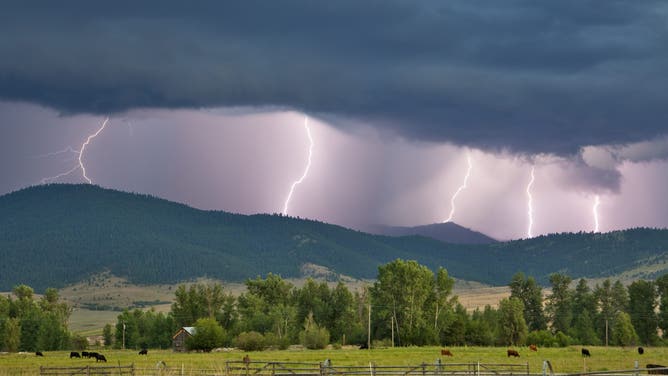‘Flee the tree:’ Florida teen’s lightning death just latest illustrating myth of outdoor safety during storms
A Florida teen died Monday nearly a month after the tree she was under was struck by lightning. Experts with the National Lightning Safety Council say "flee the tree" is important to remember along with the tried and true "when the thunder roars, go indoors."
Recent lightning-related deaths now bring national death toll to 9
A Utah fisherman was killed Sunday after lightning struck a boat; it's the third lightning-related injury incident this month in the U.S. and ninth death overall in the nation this year.
While U.S. lightning deaths have dropped significantly over the past 20 years, there are still preventable tragedies that occur every year, highlighting the need for continued awareness, especially as school starts and fall sports mean more time outdoors for student-athletes.
Summer is the time when the most fatal lightning strikes happen in the U.S., as more people are outdoors doing what they enjoy.
In recent weeks, three serious and fatal lightning incidents have occurred in Florida, Utah, and Montana. So far this year, nine lightning deaths have occurred. Over the past 10 years, the U.S. has averaged about 18 deaths from lightning by mid-August.
The most recent lightning victims were enjoying outdoor sports or activities when they were struck.
GOLF JOINS LIGHTNING’S ‘DEADLY DOZEN’ LIST
Ashley King, 16, of St. Petersburg, Florida, died on Monday nearly a month after she and three friends were standing under a tree when it was hit by lightning.
Chris Vagasky, Meteorologist Lightning Data and Safety Specialist with the National Lightning Safety Council, said sheltering under a tree is a safety misconception.
"Trees tend to be tall, isolated and pointy, which is what makes them prone to being struck by lightning," Vagasky said. "The lightning will strike the tree. The electricity travels through the tree. It may jump from the tree into you, or the electricity may travel through the ground and then into you."
Lightning safety expert weighs in on thunderstorm that left 2 injured after they were struck on Coney Island beach
FILE VIDEO: National Lightning Safety Council's Chris Vagasky joined FOX Weather to talk about how to stay safe in thunderstorms in the wake of the incident at Coney Island on the 4th of July in 2023 that left two injured from a lightning strike.
Those at the National Lightning Safety Council are telling the public to "flee the tree" to get across the point that just because you are dry and sheltered from rain does not mean you are safe. The only safe place from lightning is inside a building or a vehicle.
BOLTING IT: WHY YOU SHOULD RUSH INDOORS WHEN YOU SEE LIGHTNING OR HEAR THUNDER
"The substantial building or that fully enclosed metal vehicle, if lightning strikes that, you have a Faraday cage around you," Vagasky said. "So the electricity from the lightning travels through the metal shell of the car, or the metal shell of the airplane or it travels through the electrical and the plumbing in the walls and avoids you."
On Sunday, a 24-year-old fisherman was one of three struck by lightning while on their boat on Bear River in Utah. Two of the anglers were able to swim to safety, but one did not make it.
Most lightning fatalities happen at the beach, on a boat, or while someone is fishing.
"When you're on a boat, there's not usually anything taller than you unless you've got a sailboat or a mast," Vagasky said. "When you're fishing, and you're holding a fishing rod, you are cut out in the open, holding up something tall and pointy. And if you're at the beach, it's you and anybody else at the beach."
LIGHTNING SAFETY: WHEN THUNDER ROARS, EVEN TAKING OUT THE TRASH CAN TURN DEADLY
In addition to being on the tallest thing around, the surrounding water will conduct electricity.
Peak lightning season ends as fall sports begin
Two soccer players and a coach were injured on Monday evening by a lightning strike on a field at Glacier High School in Kalispell, Montana. The three were treated at a local hospital and one player remains in the Intensive Care Unit.

FILE: Lightning strikes over Montana.
(Chuck Haney / Design Pics Editorial / Universal Images Group / Getty Images)
Peak lightning season runs from June through August. The peak season may end in August when schools are back in session, but thunderstorms still occur as fall sports are ongoing. Vagasky recommends all sports teams have a lightning plan, which could be as basic as remembering "when thunder roars, go indoors."
"It could be more complex, having lightning detection, having designated weather watchers and designated shelters and things like that," he said. "But every outdoor venue, every outdoor event needs to have a lightning safety plan."
A lightning plan doesn't need to include the "lightning crouch," which was debunked in 2088 as an effective method of avoiding a strike. It used to be taught to athletes on the field to crouch as low as they could on the balls of their feet. But Vagasky said since lightning can jump in 50 to 150-foot increments, dropping your height a few feet won't make much of a difference. Instead, it's best to focus on getting to a lightning-safe place.
WHAT HAPPENS WHEN SOMEONE IS STRUCK BY LIGHTNING
America ranks low in the number of lightning fatalities worldwide, which total over 24,000.
Lightning fatalities in the U.S. have declined with increasing awareness. Last year there were 14, according to the National Lightning Safety Council. However, before anyone rules out it could happen to them, Vagasky said there are nearly 56 million cloud-to-ground lightning strikes a year in the U.S.
"That's a lot of lightning that hits the ground every year," he said. "So, and we're trying to get people to understand that just because it didn't happen this time doesn't mean the next time it doesn't."

